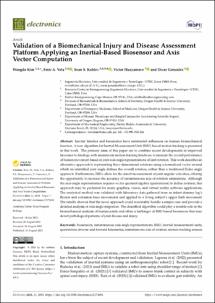Mostrar el registro sencillo del ítem
Validation of a Biomechanical Injury and Disease Assessment Platform Applying an Inertial-Based Biosensor and Axis Vector Computation
| dc.contributor.author | Kim, Wangdo | |
| dc.contributor.author | Vela, Emir A. | |
| dc.contributor.author | Kohles, Sean | |
| dc.contributor.author | Huayamave, Victor | |
| dc.contributor.author | Gonzalez, Oscar M. | |
| dc.date.accessioned | 2023-10-25T15:39:10Z | |
| dc.date.available | 2023-10-25T15:39:10Z | |
| dc.date.issued | 2023-08-31 | |
| dc.identifier.citation | Kim, W., Vela, E. A., Kohles, S. S., Huayamave, V., & Gonzalez, O. (2023). Validation of a Biomechanical Injury and Disease Assessment Platform Applying an Inertial-Based Biosensor and Axis Vector Computation. Electronics, 12(17), 3694. MDPI. http://dx.doi.org/10.3390/electronics12173694 | es_PE |
| dc.identifier.uri | https://hdl.handle.net/20.500.12815/336 | |
| dc.description.abstract | Inertial kinetics and kinematics have substantial influences on human biomechanical function. A new algorithm for Inertial Measurement Unit (IMU)-based motion tracking is presented in this work. The primary aims of this paper are to combine recent developments in improved biosensor technology with mainstream motion-tracking hardware to measure the overall performance of human movement based on joint axis-angle representations of limb rotation. This work describes an alternative approach to representing three-dimensional rotations using a normalized vector around which an identified joint angle defines the overall rotation, rather than a traditional Euler angle approach. Furthermore, IMUs allow for the direct measurement of joint angular velocities, offering the opportunity to increase the accuracy of instantaneous axis of rotation estimations. Although the axis-angle representation requires vector quotient algebra (quaternions) to define rotation, this approach may be preferred for many graphics, vision, and virtual reality software applications. The analytical method was validated with laboratory data gathered from an infant dummy leg’s flexion and extension knee movements and applied to a living subject’s upper limb movement. The results showed that the novel approach could reasonably handle a simple case and provide a detailed analysis of axis-angle migration. The described algorithm could play a notable role in the biomechanical analysis of human joints and offers a harbinger of IMU-based biosensors that may detect pathological patterns of joint disease and injury. | es_PE |
| dc.format | application/pdf | es_PE |
| dc.language.iso | eng | es_PE |
| dc.publisher | Multidisciplinary Digital Publishing Institute (MDPI) | es_PE |
| dc.rights | info:eu-repo/semantics/openAccess | es_PE |
| dc.source | Repositorio Institucional UTEC | es_PE |
| dc.source | Universidad de Ingeniería y Tecnología - UTEC | es_PE |
| dc.subject | Biosensors | es_PE |
| dc.subject | Instantaneous axis-angle representations | es_PE |
| dc.subject | IMU | es_PE |
| dc.subject | Inertial measurement units | es_PE |
| dc.subject | Quaternions | es_PE |
| dc.subject | Inverse and forward kinematics | es_PE |
| dc.subject | Instantaneous axis of rotation | es_PE |
| dc.subject | Motion tracking sensors | es_PE |
| dc.title | Validation of a Biomechanical Injury and Disease Assessment Platform Applying an Inertial-Based Biosensor and Axis Vector Computation | es_PE |
| dc.type | info:eu-repo/semantics/article | es_PE |
| dc.subject.ocde | https://purl.org/pe-repo/ocde/ford#2.03.01 | es_PE |
| dc.publisher.country | Perú | es_PE |
| dc.identifier.doi | https://doi.org/10.3390/electronics12173694 | |
| dc.identifier.journal | Electronics | es_PE |

